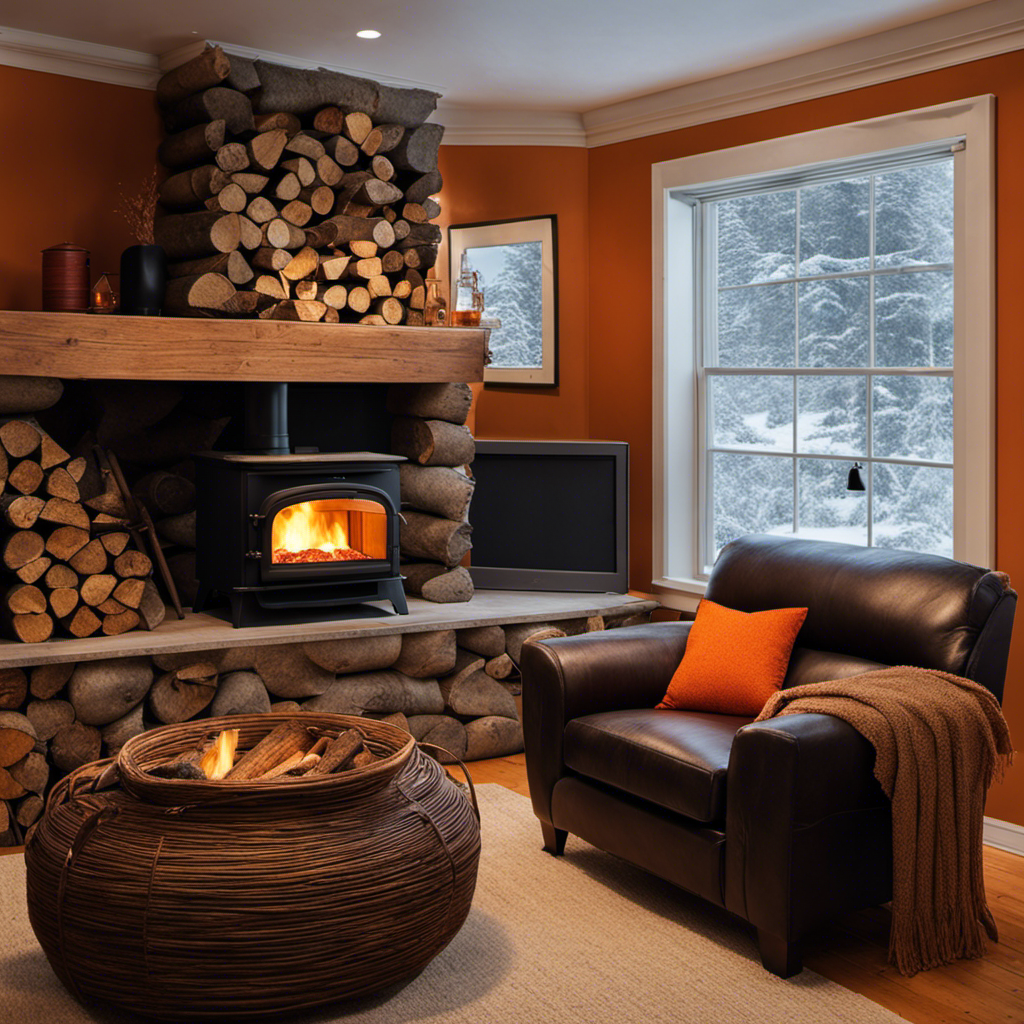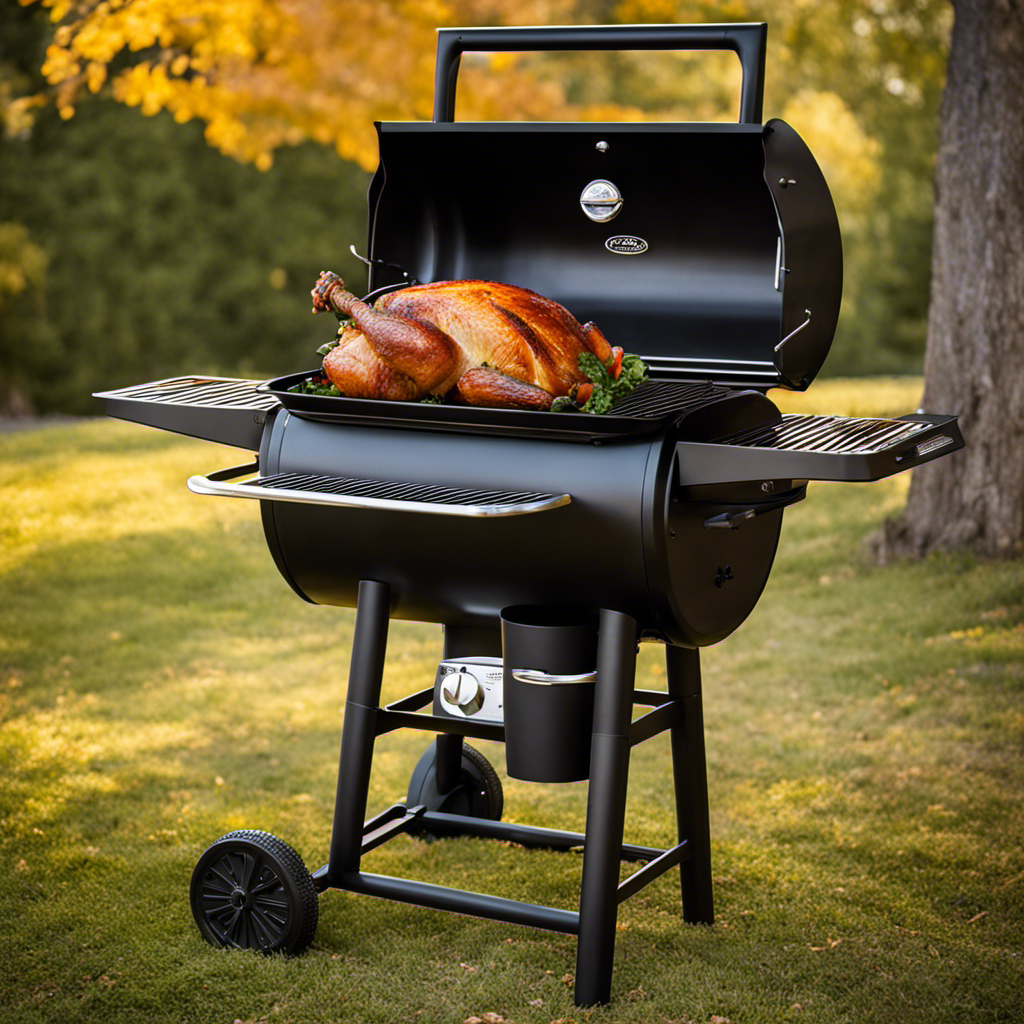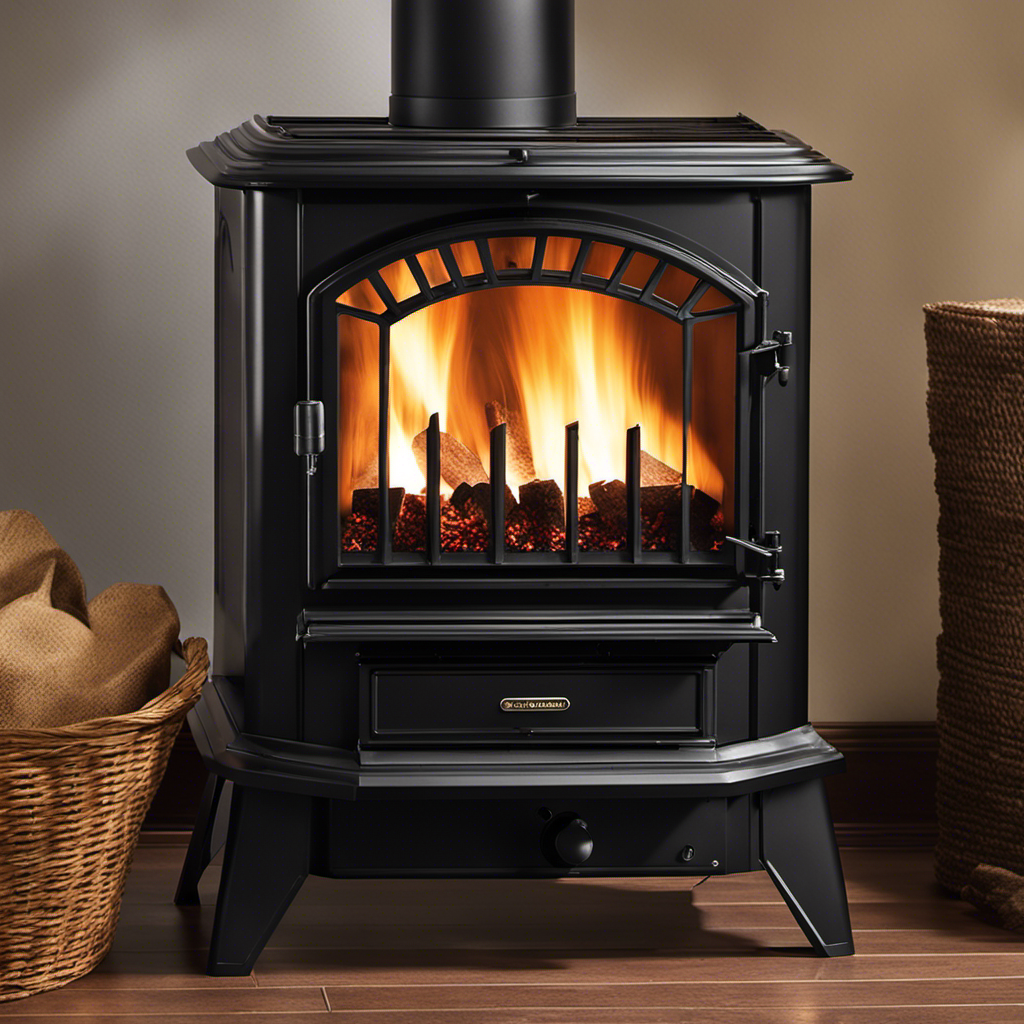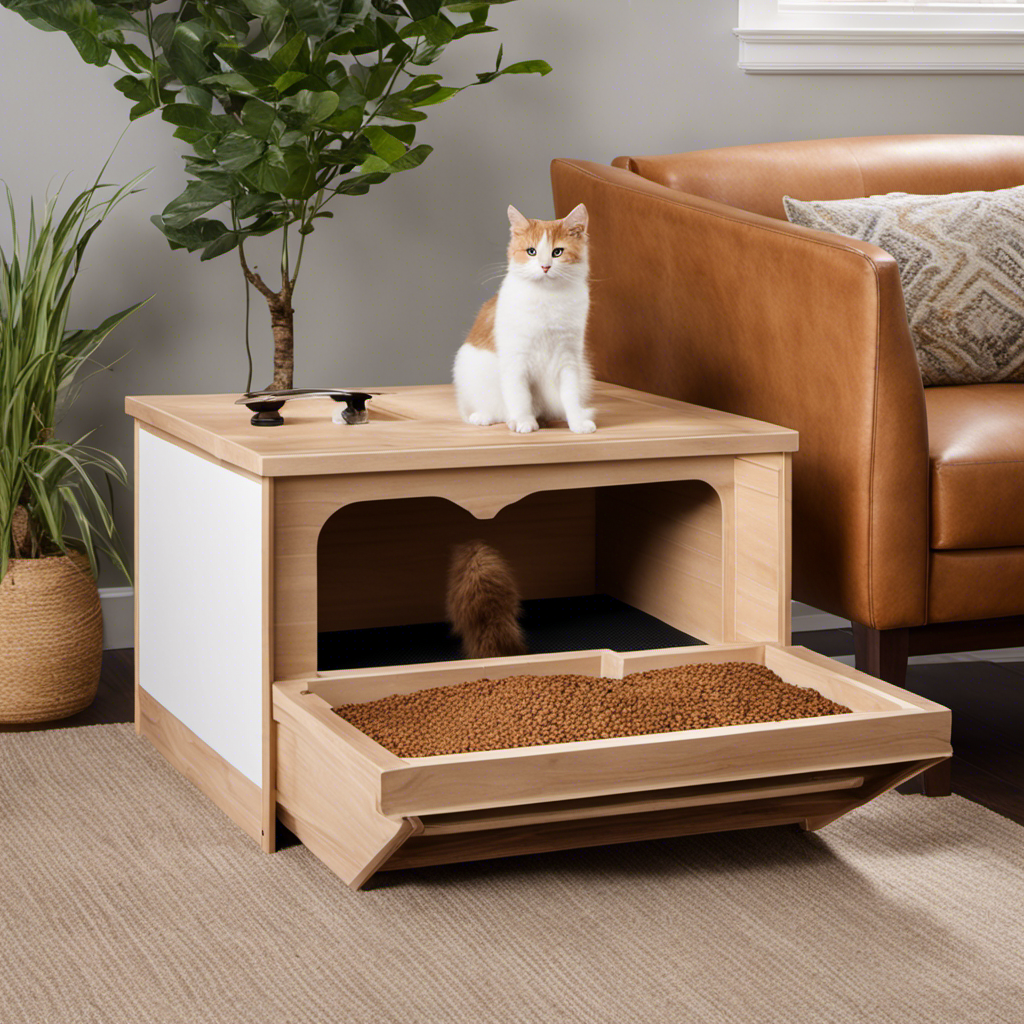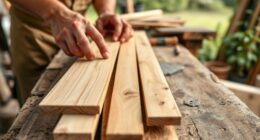As a person who has always been attracted to the cozy and inviting glow of a dancing flame, I frequently ponder: which is superior, a pellet or a wood stove?
In this article, we will delve into the cost-effectiveness, environmental impact, heating efficiency, fuel availability, maintenance requirements, heat output, installation options, and aesthetics of both options.
By exploring these factors objectively and analytically, we aim to guide you towards making an informed decision for your home heating needs.
Key Takeaways
- Pellet stoves are more cost-effective and have a lower environmental impact compared to wood stoves.
- Wood stoves have a higher heat output and are generally more efficient than pellet stoves.
- Pellets are easier to source and require less storage space compared to firewood.
- Maintenance requirements and cleaning frequency differ between wood and pellet stoves.
Cost-effectiveness
If you’re looking to save money in the long run, a pellet stove may be more cost-effective than a wood stove. When considering fuel prices, pellets tend to be cheaper and more stable compared to firewood. Pellets are made from compressed sawdust and other organic materials, making them readily available and less expensive to produce.
Additionally, pellet stoves are highly efficient in burning fuel, which means they require less fuel overall. This translates into long-term savings for homeowners. With rising energy costs, investing in a pellet stove can provide significant financial benefits over time.
Furthermore, the technology behind pellet stoves has improved greatly, making them even more efficient and environmentally friendly.
Transitioning now into the discussion on environmental impact…
Environmental Impact
The environmental impact of using a pellet stove is lower than a wood stove. When it comes to carbon footprint and air quality, pellet stoves have several advantages over their wood-burning counterparts. Pellets are made from compressed sawdust and other biomass materials, which are renewable resources that produce less carbon dioxide when burned compared to traditional firewood. Additionally, the combustion process in pellet stoves is more efficient and cleaner, resulting in reduced emissions of harmful pollutants such as particulate matter and volatile organic compounds (VOCs). To highlight the environmental benefits of pellet stoves, here is a table comparing the carbon footprint and air quality aspects of both types of stoves:
| Aspect | Pellet Stove | Wood Stove |
|---|---|---|
| Carbon Footprint | Lower | Higher |
| Air Quality | Better | Worse |
Considering these factors, it is clear that pellet stoves offer a greener heating solution compared to wood stoves. Now let’s explore the next section about heating efficiency.
Heating Efficiency
When it comes to heating efficiency, comparing pellet and wood stoves is essential. I will discuss three key points: the efficiency of pellet vs wood stoves, the heat output comparison between the two options, and an analysis of their energy consumption.
Pellet Vs Wood Efficiency
Wood stoves are generally more efficient than pellet stoves. While both options provide warmth and comfort, it’s important to consider the cost and environmental impact associated with each.
Here are some key points to consider:
-
Cost: Wood is often cheaper than pellets, especially if you have access to your own source of firewood.
-
Environmental impact: Burning wood releases carbon dioxide into the atmosphere, contributing to climate change. Pellets, on the other hand, are made from compressed sawdust or agricultural waste, making them a more sustainable choice.
-
Availability: Wood is widely available in many regions, while pellets may be easier to find in urban areas or where firewood is scarce.
-
Maintenance: Wood stoves require regular cleaning and loading of firewood, whereas pellet stoves need periodic ash removal and refilling of pellet hoppers.
-
Energy efficiency: Wood stoves have a higher heat output compared to pellet stoves due to their ability to burn larger logs.
Considering these factors can help you make an informed decision when choosing between a wood or pellet stove for your heating needs.
In terms of heat output comparison…
Heat Output Comparison
In terms of heat output, it’s important to consider the size of logs that can be burned in a wood stove compared to a pellet stove. Wood stoves typically have larger fireboxes, allowing for bigger logs and longer burn times. This means they have a higher heating capacity and can produce more heat for longer periods of time compared to pellet stoves.
However, pellet stoves offer better fuel efficiency and cost savings in the long run. They use compressed wood pellets as fuel, which are more uniform in size and density, resulting in consistent heat output. Additionally, pellets tend to be cheaper than firewood, making them a more economical choice for heating your home.
Now let’s analyze the energy consumption of these two types of stoves without further ado.
Energy Consumption Analysis
Let’s now consider the energy consumption of these two types of stoves, focusing on their efficiency and cost-effectiveness.
-
Pellet stoves are known for their high energy efficiency, with an average efficiency rating of 70-90%. This means that they convert a higher percentage of fuel into usable heat compared to wood stoves, which typically have an efficiency rating ranging from 60-80%.
-
When it comes to cost-effectiveness, pellet stoves tend to be more expensive upfront due to the cost of installation and the price of pellets. However, they can save money in the long run by burning fuel more efficiently.
-
In terms of carbon footprint, both pellet and wood stoves produce carbon emissions when burning fuel. However, pellet stoves generally emit fewer pollutants into the atmosphere due to their cleaner combustion process.
Considering these factors, it becomes clear that pellet stoves offer higher energy efficiency and potentially lower environmental impact than wood stoves.
Moving forward to our discussion on fuel availability…
Fuel Availability
You might find it easier to source pellets for a pellet stove compared to finding firewood for a wood stove. The availability of fuel is an important factor to consider when choosing between these two types of stoves.
Pellets, which are typically made from compressed sawdust or agricultural waste, can be easily purchased from local suppliers or even online. This means that you don’t have to rely solely on your own ability to find and chop firewood.
In contrast, firewood for a wood stove may not always be readily available in your area, especially if you live in an urban environment or don’t have access to a reliable source.
Transitioning into the subsequent section about maintenance requirements, let’s now explore another aspect of these stoves: their maintenance needs.
Maintenance Requirements
When it comes to maintaining a stove, there are several key factors to consider. Cleaning frequency, fuel storage needs, and chimney maintenance costs are all important aspects to keep in mind.
Cleaning frequency varies depending on the type of stove and how often it is used. However, it is generally recommended to clean the stove at least once a year. This helps to keep it in good working condition and prevent any potential issues.
Fuel storage needs will also vary depending on the type of stove. Wood stoves, for example, require ample space for storing logs. On the other hand, pellet stoves require a designated area for storing pellets. It’s important to have enough storage space to ensure that you have fuel readily available when you need it.
Lastly, chimney maintenance costs can be significant. Regular inspections and cleanings are necessary to prevent creosote buildup and ensure proper ventilation. These costs should be factored into your overall stove maintenance budget.
Cleaning Frequency
The cleaning frequency for a wood stove is typically lower than that of a pellet stove. When comparing the fuel types, it’s important to consider the cleaning techniques required for each.
Wood stoves burn logs or wood pellets, which produce ash and soot as byproducts. The ash needs to be removed periodically, usually after every 1-2 weeks of use. Soot buildup on the glass door can also occur and requires regular cleaning with appropriate materials.
On the other hand, pellet stoves burn compressed wood pellets that produce minimal ash residue compared to traditional firewood. Cleaning the pellet stove involves emptying and vacuuming out the ash pan once a week or every few days depending on usage. This difference in cleaning frequency highlights one aspect of maintenance when choosing between these two fuel options.
In terms of fuel storage needs…
Fuel Storage Needs
In terms of fuel storage, it’s important to consider the amount of space available for storing logs or wood pellets. When it comes to a pellet stove, the fuel storage capacity is usually smaller compared to a wood stove. Wood stoves can accommodate larger logs, which means you may need more space for storing them. On the other hand, pellet stoves require less space as they use compressed wood pellets that come in bags or bins.
The location of your fuel storage also plays a role in convenience and accessibility. It’s ideal to have it close to your stove for easy refilling.
Now, let’s transition into discussing chimney maintenance costs without skipping a beat.
Chimney Maintenance Costs
You’ll want to budget for regular chimney maintenance, as it can be a significant cost associated with owning a fireplace. Proper chimney cleaning and repair are essential for the safety and efficiency of your fireplace. Neglecting these tasks can lead to hazardous conditions, such as chimney fires or carbon monoxide leaks. To give you an idea of the potential costs involved, here is a breakdown of common chimney maintenance expenses:
| Maintenance Task | Average Cost |
|---|---|
| Chimney Cleaning | $200 – $300 |
| Chimney Repair | $500 – $1500 |
These costs may vary depending on factors such as the size and condition of your chimney, as well as any additional repairs needed. It’s important to hire a professional for these services to ensure they are done correctly and to avoid further damage. Once you have accounted for the expenses of chimney maintenance, let’s delve into understanding heat output in pellet and wood stoves.
[Transition sentence: Now that we’ve covered the costs associated with chimney maintenance, let’s explore the topic of heat output in pellet and wood stoves.]Heat Output
A pellet stove can produce more heat than a wood stove due to the fuel type and heating capacity of pellet stoves. Pellet stoves use compressed wood pellets as fuel, which have a higher energy density compared to traditional firewood used in wood stoves. The combustion process in pellet stoves is also more efficient, resulting in a greater amount of heat being generated. Additionally, pellet stoves often come with variable heat settings, allowing users to adjust the heating capacity according to their needs. This means that pellet stoves can provide a consistent and controllable heat output throughout the day.
In contrast, wood stoves rely on the size and quality of the firewood for their heating capacity, making it less predictable. When considering heat output, a pellet stove offers superior performance compared to a wood stove.
When it comes to installation options…
Installation Options
One of the advantages of a pellet stove is that it can be installed in multiple ways to suit different homes and preferences. There are several installation types available for pellet stoves, including freestanding, fireplace insert, and wall-mounted options.
Freestanding pellet stoves are versatile and can be placed anywhere in the room as long as there is proper ventilation.
Fireplace inserts are designed to fit into existing fireplaces, making them a great option for homeowners who want to convert their traditional wood-burning fireplace into a more efficient heating source.
Wall-mounted pellet stoves are perfect for small spaces where floor space is limited. When considering installation, it’s important to take into account the space requirements of each type and choose one that fits well within your home’s layout.
With various installation options available, you can easily find a suitable solution for your heating needs.
Transitioning into the next section about aesthetics:
In addition to the practical aspects of installation, it’s also worth considering how a pellet stove will complement your home’s aesthetic appeal.
Aesthetics
When it comes to interior design, the aesthetics of a pellet or wood stove can play a significant role in determining which option is better. Both types of stoves have their own unique visual appeal.
Wood stoves are often favored for their rustic and traditional look. The crackling flames and the warm glow create a cozy atmosphere that many homeowners find appealing. Wood stoves come in various designs, from classic cast iron to more contemporary styles, allowing them to blend seamlessly with different interior decors.
On the other hand, pellet stoves offer a sleek and modern aesthetic. These stoves often have clean lines and can be found in a range of colors and finishes. They provide a sophisticated touch to any room while still delivering efficient heat.
Ultimately, the choice between pellet or wood stove aesthetics depends on personal preference and how well it complements your interior design style.
Frequently Asked Questions
Can a Pellet Stove Be Used as a Primary Heating Source for an Entire Home?
Yes, a pellet stove can be used as the primary heating source for an entire home. It is more energy-efficient than wood stoves and has a lower environmental impact due to cleaner combustion and the use of renewable biomass pellets.
Are Wood Stoves More Expensive to Install Than Pellet Stoves?
Wood stoves can be more expensive to install than pellet stoves due to the need for a chimney or flue system. However, the benefits of pellet stoves include lower fuel costs and cleaner emissions.
How Often Do Pellet Stoves Need to Be Cleaned and Maintained Compared to Wood Stoves?
Pellet stoves require regular cleaning to remove ash and soot buildup, typically every 1-2 weeks. Maintenance requirements include inspecting the exhaust system, checking for pellet jams, and ensuring proper ventilation.
Can a Wood Stove Be Converted to Burn Pellets?
Converting a wood stove to burn pellets can be a convenient option for some. The conversion process involves installing a pellet burner and modifying the stove. However, it’s important to consider the benefits and drawbacks before making the switch.
Do Pellet Stoves Produce as Much Heat as Wood Stoves?
In terms of heating efficiency, pellet stoves and wood stoves differ. Pellet stoves are known for producing consistent heat due to their automated fuel delivery system. However, wood stoves provide a more traditional and cozy ambiance. Both options have pros and cons regarding environmental impact as well.
Conclusion
In conclusion, after carefully considering the various factors, it is clear that both pellet and wood stoves have their advantages and disadvantages.
While wood stoves offer a traditional and charming aesthetic, pellet stoves are more cost-effective and environmentally friendly.
When it comes to heating efficiency, fuel availability, and maintenance requirements, both options have their merits.
Ultimately, the decision between pellet or wood stove will depend on individual preferences and needs.
As the saying goes, ‘Different strokes for different folks.’

